BSc 1st Year Botany Vegetative Reproduction in Bryophytes Sample Model Practice Question Answer Papers
BSc 1st Year Botany Vegetative Reproduction in Bryophytes Sample Model Practice Question Answer Papers: BSc is a three-year program in most universities. Some of the universities also offer BSc Honours. After getting enrolled for BSc, there are certain things you require the most to get better grades/marks in BSc. Out of those, there are BSc Study Material, BSc Sample Model Practice Mock Question Answer Papers along with BSc Previous Year Papers. At gurujistudy.com you can easily get all these study materials and notes for free. Here in this post, we are happy to provide you with BSc 1st Year Botany Vegetative Reproduction in Bryophytes Sample Model Practice Question Answer Papers.

- BSc 1st Year Botany Vegetative Reproduction in Bryophytes Sample Model Practice Question Answer Papers
Q. 1. Describe the various methods of vegetative reproduction in Bryophytes.
Ans.1. One of the characteristic features of the bryophytes is their tendency towards vegetative reproduction by a large variety of means. (BSc 1st Year Botany Vegetative Reproduction in Bryophytes Sample Model Practice Question Answer Papers)
Correns (1899) and Cavers (1903) have collected and summarized the various method of vegetative reproduction in bryophytes as follows:
(i) By death and decay method
In most of the thallose, dichotomously branched bryophytes, the plants reproduce vegetatively by the progressive death and decay of the older part as the decay reaches the dichotomy, the two branches of the thallus separate from each other and begin to develop in two new thalli. This method is quite common in Riccia, Marchantia, Pellia and Anthoceros. In mosses (Bryidae) the prostrate branches die and erect branches borne by them become independent plants.
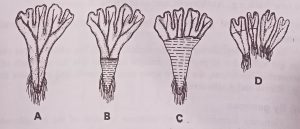
(ii) By the formation of adventitious branches
In this case the adventitious branches are given from the ventral surface of thallus. These adventitious branches get detached from the parent plant, and form a new thalli. This method is quite common in Riccia (R. fluitans) Marchantia and is some Jungermanniales e.g., Pellia, Blasia, etc.
(iii) By the formation of innovations
In few cases e.g., Sphagnum and some Jungermanniales, one of the upright branches of the tuft continues-growth and become independent due to death of the tissue bearing such branches.
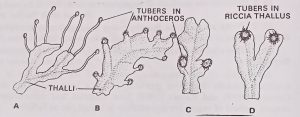
(iv) By tuber formation
In this method, during the unfavourable period, the gametophyte become thick along the margins and these thickened areas develops protective covering. The thickened portions are called tubers. These tubers can perennate unfavourable season and long drought while the remaining thallus dies. On the approach of favourable climatic conditions, the tuber gives rise to new thalli, e.g., Anthoceros, species of Riccia, R. vesicata, etc.
(v) By peristent growing apicies of thallus during unfavourable season
In this method during the unfavourable period, the whole thallus except tips gets killed due to prolonged drought and heat. On the approach of the favourable conditions, the tissue again resumes growth and gives new thalli, e.g., Riccia and Anthoceros. (BSc 1st Year Botany Vegetative Reproduction in Bryophytes Sample Model Practice Question Answer Papers)
(vi) By gemmae
Gemmae formation is very common in most of the bryophytes for the vegetative reproduction. But the structure and formation of gemmae is slightly different in different groups of bryophytes as follows:
(A) Hapticae
In Marchantia, multicellular, stalked, green discoid gemmae produced inside gemmae cups on the dorsal surface of thallus. Each gemmae producetwo new thalli. (BSc 1st Year Botany Vegetative Reproduction in Bryophytes Sample Model Practice Question Answer Papers)
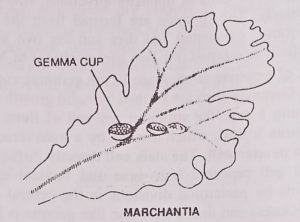
The gemmae which are the special reproductive bodies, produced in large number in small gemmae cups. Each gemmae has a small stalk and a multicellular discoid body it is thick in the middle and thin at margins. There are two notches on the lateral sides which are diagrammatically opposite. Most of the cells of a gemmae contain chloroplast, while few process oil. There are some rhizoidal cells also.
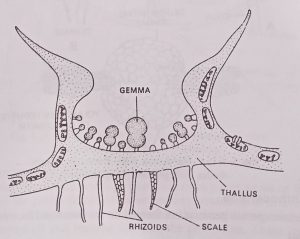
Each gemmae after falling on the soil and on the approach of favourable conditions develops into two thallus of Marchantia gametophyte. First of all two apical cells in the two notches become active and begin to grow and develop in the same manner as those at the growing tip of a branch. Due to the activities of these two cells in opposite directions, two young thalli are formed simultaneously. The rhizoids are formed from the rhizoidal cells. Ultimately the gemmae exhausted and die and the two young, thalli get separated. These thalli developed into two gametophytes of Marchantia.
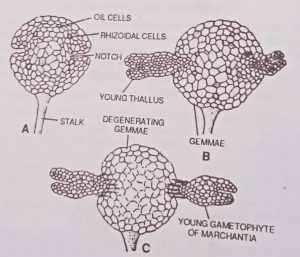
Development of gemmae takes place in the gemmae cups on the dorsal surface of thallus, Gemmae cups are formed by rapid growth of neighbouring cells. Thus assuming a cup like structure any cell of floor of gemmae cup functions as gemmae initial, which divides by a transverse division into a stalk cell, gemma proper cell. The stalk cell directly forms one-celled stalk while the gemma cell repeated transverse and vertical divisions from a gemma. Afterwards by pericilinal divisions in the central cells in become several cells in thickness and thus a oval disc like gemma is formed. (BSc 1st Year Botany Vegetative Reproduction in Bryophytes Sample Model Practice Question Answer Papers)
(B) In Anthocerotae
In certain species gemmae are formed on the dorsal surface of thallus.
(C) Musci
Various types of gemmae have been observed in various types mosses, which help in vegetative reproduction. In some cases the multicellular gemmae are formed on the tips of leaves or on the side of branches. In Funaria gemmae are formed on the rhizoids which is often called as bulbils.
(vii) By the formation of protonema
In musci the spores on germination form the protonemal stage of gametophyte. These protonema are known as primary protonema. These protonema are filamentous branched and gives several buds. Each bud can form a new gametophore. Sometimes the protonema breaks in fragment give rise the new protonema which again multiply and bear buds. In this way by protonema formation one spore of moss plant forms several moss plants.
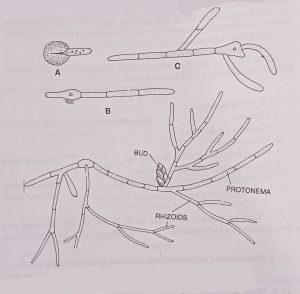
(viii) By Secondary Protonema Formation
The protonema which develops from the primary protonema or from any living cell of the plants is known as secondary protonema. In some cases e.g., Funaria, Sphagnum and other mosses the rhizoids come out the soil, develop chlorophyll and become just like the protonema. This secondary protonema gives rise to new gametophytes like that of primary protonema. In few cases the secondary protonema may develop from the wounded portion of the leafy shoot from the marginal cell of the protonema.
Perennation in Bryophyta
Perennation includes the methods employed by plants to pass through unfavourable period for vegetative growth. In the perennation period normally all the activities of an organism ceases and to pass through these unfavourable period the living organisms develop some protective means at any stage of life cycle. (BSc 1st Year Botany Vegetative Reproduction in Bryophytes Sample Model Practice Question Answer Papers)
Among bryophytes the high temperature and drier conditions are usually the unfavourable periods and to pass through these unfavourable periods the plants develop certain devices which enable them to carry through the period for severe conditions into the next growing season. The main methods of perennation in bryophytes are:
(1) By tuber formation.
(2) By persistant growing apices, etc.
BSc 1st Year Botany Vegetative Reproduction in Bryophytes Sample Model Practice Question Answer Papers
BSc 1st Year Botany Vegetative Reproduction in Bryophytes Sample Model Practice Question Answer Papers
BSc 1st Year Sample Model Practice Mock Test Question Answer Papers
BSc 1st Year Botany Vegetative Reproduction in Bryophytes Sample Model Practice Question Answer Papers
BSc 1st Year Botany Vegetative Reproduction in Bryophytes Sample Model Practice Question Answer Papers